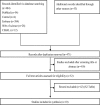Aminoglycoside use and intensive care unit-acquired weakness: A systematic review and meta-analysis
- PMID: 32191708
- PMCID: PMC7082020
- DOI: 10.1371/journal.pone.0230181
Aminoglycoside use and intensive care unit-acquired weakness: A systematic review and meta-analysis
Abstract
Background: The relationship between aminoglycoside use and intensive care unit (ICU)-acquired weakness remains controversial. In the present study, we performed a systematic review and meta-analysis to examine the relationship between aminoglycoside use and ICU-acquired weakness in critically ill patients.
Methods: The PubMed, Embase, Web of Science, Cochrane Central Register of Controlled Trials and Cumulative Index of Nursing and Allied Health Literature databases were searched from the earliest available date to July 10, 2019. Randomized controlled trials and prospective cohort studies examining the relationship between aminoglycosides and ICU-acquired weakness in adult ICU patients were included. Two authors independently screened titles/abstracts, reviewed full text and extracted data from the included studies. We performed the Meta-analysis using Stata version 15.0 and used the DerSimonian-Laird random effects model for data analyses. Heterogeneity was evaluated using the χ2 statistic and I2 statistic. Publication bias was evaluated with funnel plots qualitatively, the Begg's test and Egger's test quantitatively.
Results: Ten prospective cohort studies were included and analysed in this review. The overall effect sizes of the studies revealed a statistically significant relationship between aminoglycoside use and ICU-acquired weakness (OR, 2.06; 95%CI, 1.33-3.21; I2 = 56%). Subgroup and sensitivity analyses suggested a significant association between aminoglycoside use and studies limited to patients with clinical weakness (OR, 2.74; 95%CI, 1.83-4.10; I2 = 0%), and not to studies limited to patients with abnormal electrophysiology (OR, 1.78; 95%CI, 0.94-3.39; I2 = 59%), a large sample size (OR, 1.81; 95%CI, 0.97-3.39; I2 = 75%), or low risk of bias (OR, 1.59; 95%CI, 0.97-2.60; I2 = 56%); however, statistical heterogeneity was obvious. There were no significant publication biases found in the review.
Conclusions: The review revealed a significant relationship between aminoglycoside use and ICU-acquired weakness.
Conflict of interest statement
The authors have declared that no competing interests exist.
Similar articles
-
Corticosteroid use and intensive care unit-acquired weakness: a systematic review and meta-analysis.Crit Care. 2018 Aug 3;22(1):187. doi: 10.1186/s13054-018-2111-0. Crit Care. 2018. PMID: 30075789 Free PMC article.
-
Incidence of intensive care unit acquired weakness in critically ill patients treated with kidney replacement therapy: A systematic review and meta-analysis.PLoS One. 2025 May 15;20(5):e0323874. doi: 10.1371/journal.pone.0323874. eCollection 2025. PLoS One. 2025. PMID: 40373018 Free PMC article.
-
Early mobilization of critically ill patients in the intensive care unit: A systematic review and meta-analysis.PLoS One. 2019 Oct 3;14(10):e0223185. doi: 10.1371/journal.pone.0223185. eCollection 2019. PLoS One. 2019. PMID: 31581205 Free PMC article.
-
A meta-analysis of the association between vasopressor use and intensive care unit-acquired weakness.Brain Behav. 2024 Sep;14(9):e70012. doi: 10.1002/brb3.70012. Brain Behav. 2024. PMID: 39236113 Free PMC article.
-
Invasive aspergillosis in critically ill patients with diabetes mellitus: a systematic review and meta-analysis.BMC Infect Dis. 2025 Jan 30;25(1):141. doi: 10.1186/s12879-025-10560-y. BMC Infect Dis. 2025. PMID: 39885384 Free PMC article.
Cited by
-
Intensive care unit-acquired weakness: Recent insights.J Intensive Med. 2023 Aug 30;4(1):73-80. doi: 10.1016/j.jointm.2023.07.002. eCollection 2024 Jan. J Intensive Med. 2023. PMID: 38263973 Free PMC article. Review.
-
A Cross-Sectional Study of the Impact of ICU-Acquired Weakness: Prevalence, Associations, and Severity.Cureus. 2023 Dec 2;15(12):e49852. doi: 10.7759/cureus.49852. eCollection 2023 Dec. Cureus. 2023. PMID: 38174172 Free PMC article.
-
Which factors are associated with acquired weakness in the ICU? An overview of systematic reviews and meta-analyses.J Intensive Care. 2024 Sep 5;12(1):33. doi: 10.1186/s40560-024-00744-0. J Intensive Care. 2024. PMID: 39232808 Free PMC article. Review.
-
One-Year Outcomes of Postintensive Care Syndrome in Critically Ill Coronavirus Disease 2019 Patients: A Single Institutional Study.Crit Care Explor. 2021 Dec 2;3(12):e0595. doi: 10.1097/CCE.0000000000000595. eCollection 2021 Dec. Crit Care Explor. 2021. PMID: 34984342 Free PMC article.
-
Influence of Early Multidisciplinary Collaboration on Prevention of ICU-Acquired Weakness in Critically Ill Patients.Dis Markers. 2022 Jul 30;2022:3823368. doi: 10.1155/2022/3823368. eCollection 2022. Dis Markers. 2022. PMID: 35942131 Free PMC article.
References
-
- Hermans G, Van Mechelen H, Clerckx B, Vanhullebusch T, Mesotten D, Wilmer A, et al. Acute outcomes and 1-year mortality of intensive care unit-acquired weakness. A cohort study and propensity-matched analysis. Am J Respir Crit Care Med. 2014; 190(4): 410–420. 10.1164/rccm.201312-2257OC . - DOI - PubMed
-
- Sharshar T, Bastuji-Garin S, Stevens RD, Durand MC, Malissin I, Rodriguez P, et al. Presence and severity of intensive care unit-acquired paresis at time of awakening are associated with increased intensive care unit and hospital mortality. Critical care medicine. 2009; 37(12): 3047–3053. 10.1097/CCM.0b013e3181b027e9 . - DOI - PubMed
Publication types
MeSH terms
Substances
LinkOut - more resources
Full Text Sources





